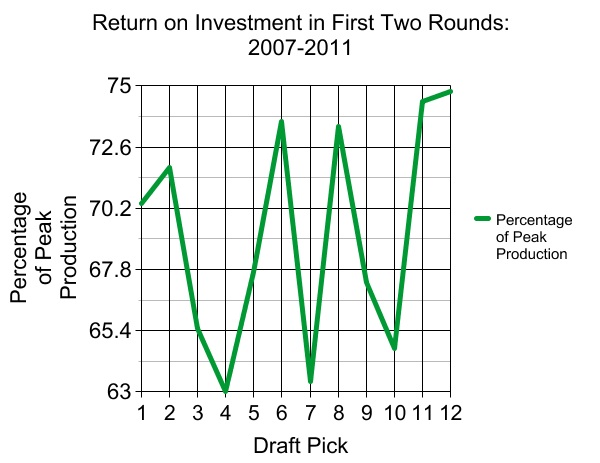 Jonathan Bales looks back at the last 5 years in this analysis of which draft spot has proven most valuable for fantasy owners.
Jonathan Bales looks back at the last 5 years in this analysis of which draft spot has proven most valuable for fantasy owners.
Note: This article is part of our preseason series that highlights quality content from premium subscription sites. RotoWire has been gracious enough to share a weekly article with our users for free. For additional RotoWire insight, you can visit RotoWire.com.
In 2007, LaDainian Tomlinson was the first pick in fantasy drafts across the country. LT delivered in a big way that year, racking up 310 fantasy points even in standard leagues – 28 more than second-place running back Brian Westbrook.
The 2007 season might not seem like anything special, but that was the last time the top overall fantasy selection ended the season No. 1 at his position (LT was really the third-best fantasy player that season, behind record-breaking years from Tom Brady and Randy Moss).
In the world of fantasy football, many of us are guilty of thinking we’re better prognosticators than we really are. The truth is that predicting the outcomes of something as complex as football is really, really tough, so it’s no surprise that fantasy owners, even as a whole, are far from perfect.
But just how good (or bad) is the general public? What’s the difference between the first draft position and the last, and what sort of return on investment might one expect with each? I wanted to answer those questions, so I spent some time tracking the relationship between fantasy draft slots and production. I included the top 20 picks from the past five seasons, analyzing fantasy points-per-game instead of overall points to correct for injuries that would throw off cumulative results.

A few points of interest:
- No. 1 picks – all running backs – have provided 82.7 percent of the production of the top player at their position. The low was Chris Johnson in 2010, who scored 70.7 percent as many points as top-scorer Arian Foster. Amazingly, three of the top four backs from 2010 – Foster, Peyton Hillis and Jamaal Charles – weren’t drafted in the top 20.
- No. 2 selections – again all running backs – have returned 80.3 percent of the production of the top-scoring back. The high was Foster last season, who led the league in fantasy points, and the low was Michael Turner in 2009 at 63.3 percent.
- After the top two picks in fantasy drafts, there has been a significant drop in production. No. 3 picks have provided 71.4 percent of peak production, and No. 4 selections check in at just 65.0 percent.
- Taking first-round selections in isolation, it appears superior to have a top-two pick over any other. After No. 2, there doesn’t appear to be much of a difference between picks No. 3 and No. 12.
- The true “cutoff” of talent over the years has been right around the 14/15 range. Since 2007, No. 14 overall picks have returned 72.4 percent of peak production. That number drops to 64.3 percent for No. 15 selections.
In the traditional snake draft format, picking last in the first round can be a good thing, because you also acquire the first pick in the second round. Since No. 13 draft picks have provided a robust 78.3 percent of peak production, the overall value of drawing the final pick in the first round is boosted.
To examine which draft spot is really the most advantageous, I combined the peak production percentages for the first two rounds of a 12-team league.

You can see the value of the first two draft spots disappears when we take the second round into consideration. Since the number of elite players has generally been around 14 per year, the last selections in a 12-team league have provided the most value. Those owners miss out on a truly top-tier talent, but they can still get their hands on two outstanding players.
Nonetheless, I’m not sure we can draw any ironclad conclusions just yet. Examining third and fourth-round picks could alter the results a bit. Further, we don’t see much of a pattern in the data above. The fluctuations in the results – the continual up-and-down that we see – makes it difficult to say which draft slots are inherently the “best.” Is the No. 6 overall pick really that much better than the No. 7 overall selection? Probably not.
Ultimately, I think the value of each draft slot really depends on the year. In 2012, picking in the top four seems advantageous, as you can land one of the top-tier running backs or Aaron Rodgers. The data suggests that you don’t need to panic if you’re picking in the back of the first round, however – the 74.8 percent return for owners picking No. 12 overall is the highest mark of any draft slot in the past five years.
![]() To view more great content like this, please visit our friends at RotoWire.com & follow them on Twitter: @RotoWire. You can also read more from Jonathan Bales in his book: Fantasy Football for Smart People: How to Dominate Your Draft
To view more great content like this, please visit our friends at RotoWire.com & follow them on Twitter: @RotoWire. You can also read more from Jonathan Bales in his book: Fantasy Football for Smart People: How to Dominate Your Draft








